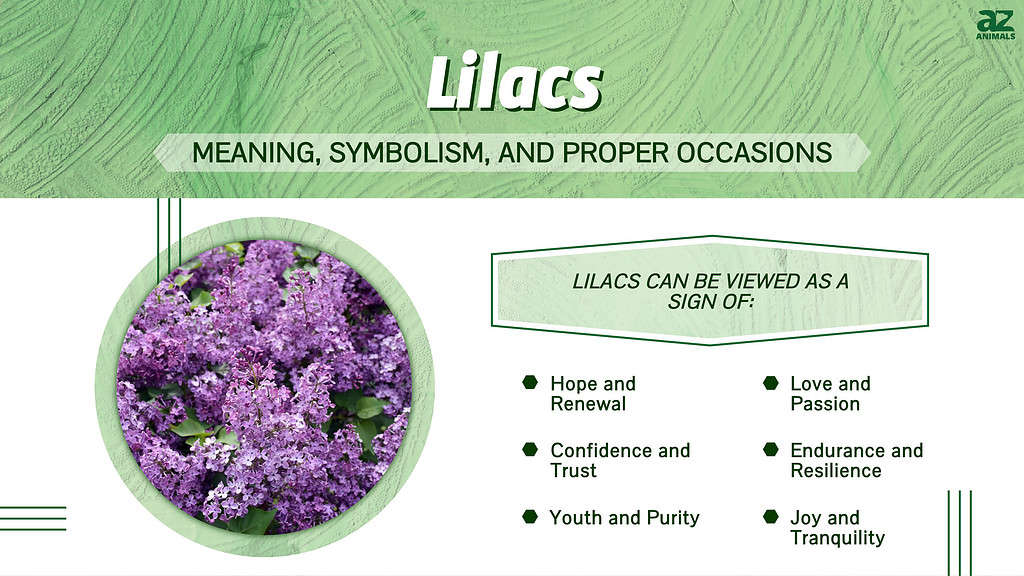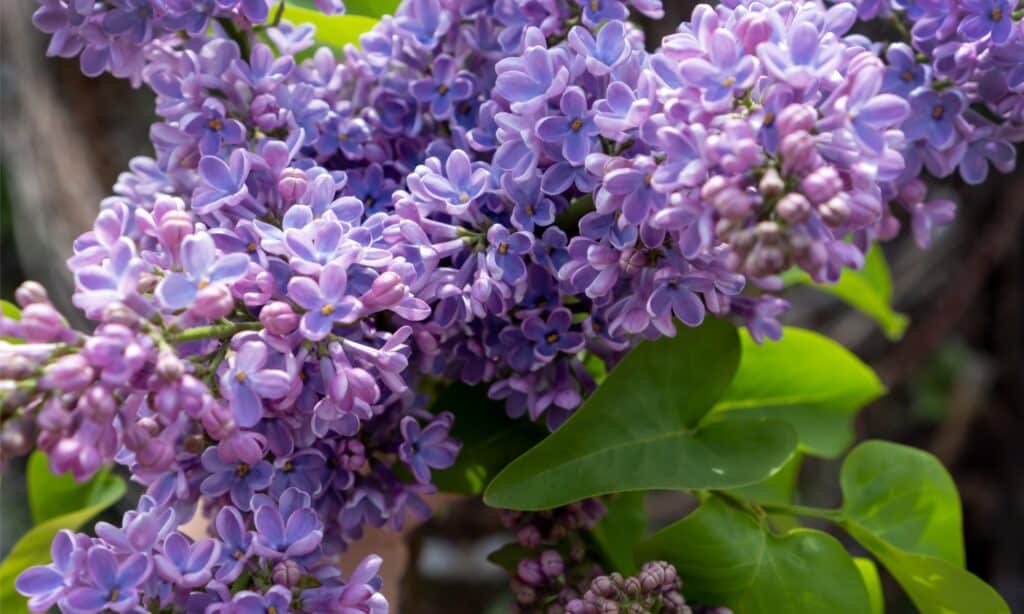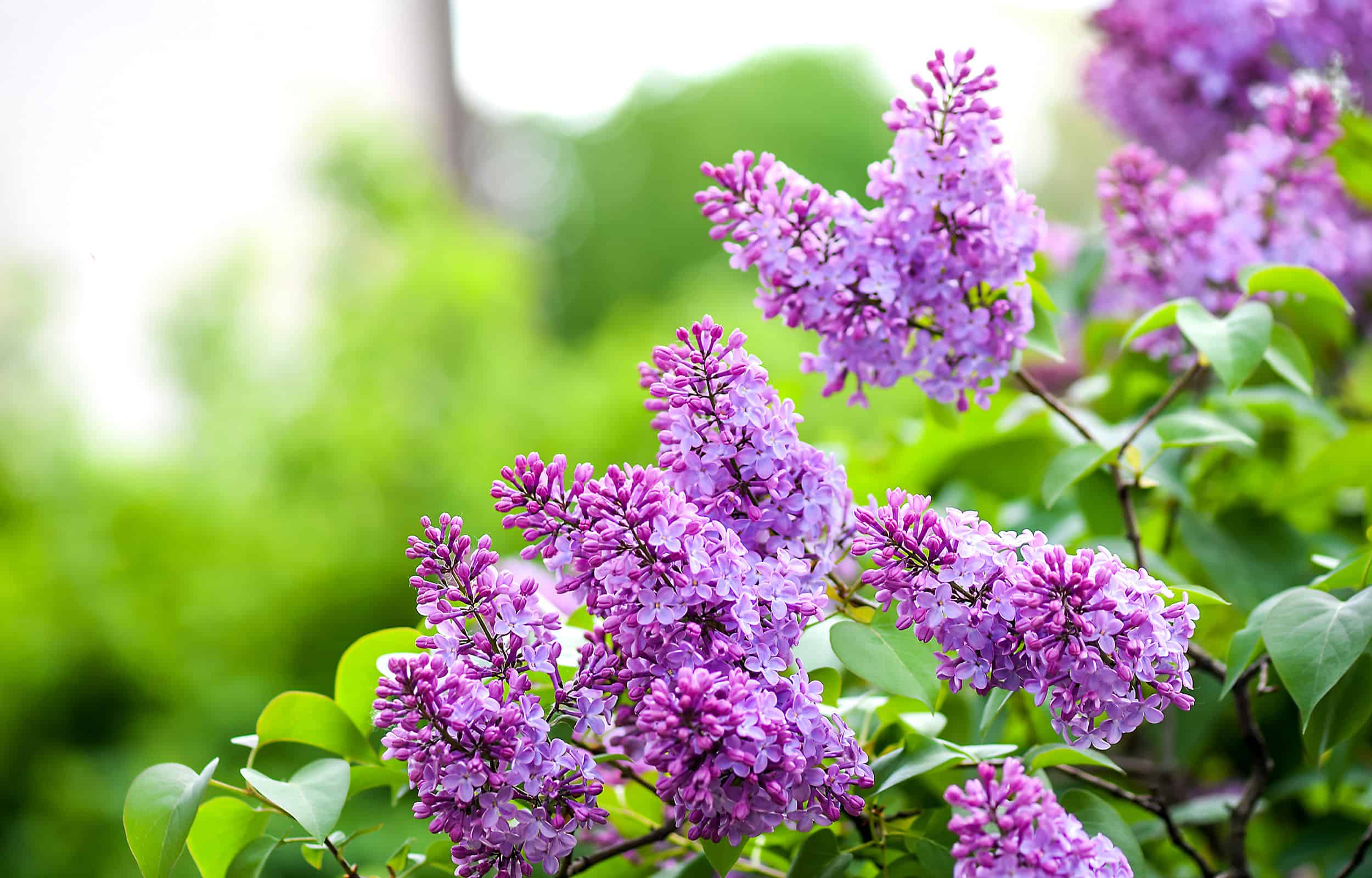Lilacs (Syringa) are popular, beautiful flowers that carry deep symbolism and have various uses. These flowering woody perennials are actually part of the olive family. In fact, they’re actually edible and pack a bitter flavor. There are over 1,000 species of lilacs, and the Japanese tree lilac (Syringa reticulata) contributes to the creation of wood products like instruments or knife handles.
Lilacs can grow on both trees and bushes (although the “tree” is still technically just a large shrub). Most commonly, however, people will purchase lilac bushes for their yards. There are hundreds of lilac bush species but only one lilac tree.
In various cultures and religions, lilacs carry positive symbolism. Spiritually, lilacs represent love, romance, renewal, and confidence, among other themes. In China, the beautiful flowering plant is a symbol of good luck. Additionally, the Celtics believed lilacs were magical flowers because of their sweet fragrance.
The common lilac (Syringa vulgaris) is said to have originated in Eastern Europe. However, most lilac species come from Asia.

Today, many adore lilacs for their gorgeous blooms and aromatic benefits. The lilacs have many different spiritual meanings, with powerful symbolism across various cultures and religions. Keep reading to learn more about what lilacs symbolize and some special occasions they’re often used for.
What Is a Lilac?
The perennial blooming lilac grows on shrubs and comes in various colors, most commonly pinks, purples, and white/off-white. They typically bloom in late spring, with flowers lasting for about three to four weeks. In fact, the common lilac is one of the longest-blooming species in its family.
Because lilacs naturally thrive as bushes, plotted lilacs (while possible) don’t typically do as well as other plants. Additionally, they might survive indoors, but they likely won’t thrive inside. Thankfully, this plant requires colder temperatures, meaning you don’t need to take them inside during colder months.

Lilac bushes add a gorgeous pop of color to any landscape or property.
©iStock.com/nobtis
Appearance
Lilacs are deciduous plants that have multiple blooms. The tall shrub grows upright and features green, heart-shaped leaves. When flowering, the many little petals grow together, appearing as a large blossom. They are typically colorful and fragrant, but many lilac bushes come in colors like white and cream as well. Depending on the type of lilac, they can grow up to 12 feet wide and 15 feet tall.
Native Habitat
While lilacs are native to both Europe and Asia (depending on the species), they’ve become a staple for the northeastern regions of the U.S. and Canada. In fact, across New England, they’re an important part of horticultural heritage. As a symbol of summer (blooming in late spring or end of May), these gorgeous flowers are showcased in the landscaping of many beach homes. They also bless the New England communities with a sweet, aromatic fragrance in the air. Lilacs also grow in some western U.S. states.
Growing Tips
Lilacs do best grown outdoors as shrubs in direct sunlight, as this helps them bloom. Experts recommend planting lilac bushes in slightly elevated areas, so they have good drainage. Their flowers typically bloom in late spring, lasting up to a month.
Lilacs can tolerate below-freezing temperatures, meaning they can survive throughout the winter. In fact, they require cold temperatures to develop their flower buds eventually. During the spring and summer, once it’s time to bloom, they prefer temperatures up to 75 degrees Fahrenheit.
In terms of fertilizer, lilacs prefer liberal amounts of a 5-10-5 granular fertilizer. Apply the fertilizer once a year in early spring (before the plant blooms).
Can Lilacs Be Grown Inside?
Lilacs are best known for growing on shrubs outdoors, and since you can’t plant a bush indoors, it’s hard for them to survive inside. However, it isn’t impossible. If you want to grow a small or dwarf potted lilac plant indoors, you might be able to enjoy its blooms with the right care. Your plant will need lots of direct sunlight (about six hours, at least) and moist soil with a balanced 10-10-10 (NPK) fertilizer.
Lilacs Meaning and Symbolism
Lilacs hold significant meanings in many cultures, symbolizing love, rebirth, and assurance. Read on to learn more about the specific meanings and symbolism associated with lilacs.

Lilacs produce blooms for a short time in the spring and are best planted in the fall.
©iStock.com/Diana Ibrasheva
Hope and Renewal
After a long, cold winter, lilacs bloom with bright-colored flowers in late spring, promising a warm summer ahead. This flower represents hope and renewal, especially after a period of prolonged darkness. Even when we feel there’s no hope left, the lilac reminds us to keep our faith and embrace rebirth/renewal. You can always start again.
Love and Passion
Lilacs represent deep love and romance. In particular, they often pay tribute to old or lost love and embody the mourning we experience when we lose someone we love. In the Victorian era, lilacs represented widows and their everlasting love for their late husbands, as well as a gesture for their “first love.”
However, they can also symbolize deep romantic love and affection, especially in the most passionate relationships.
Confidence and Trust
Lilacs are often used as symbols of confidence. When you trust in yourself and your own capabilities, you can achieve nearly anything. The lilac plant reminds us to celebrate our success and believe in our efforts, talents, and endeavors.
Endurance and Resilience
Because lilacs must survive long winters and below-freezing temperatures, they represent resilience through difficult times. In fact, in order for lilacs to eventually bloom and boast their gorgeous flowers, they actually need the cold weather in order for their buds to mature before spring/summer. Just like lilacs, we, too, must endure the hard times to reap the joy of the good times. Life is all about balance.
Youth and Purity
Lilacs (especially white or cream-colored blooms) embody the purity and innocence associated with youth. Many cultures use lilacs to represent rebirth and new life, which is closely tied to youth and a newfound innocence. No matter how old we get, we all carry that purity within us.
Joy and Tranquility
Lilacs can bring with them a sense of peace and happiness. In quaint New England, they serve as beautiful tokens of spring and summer — a time for relaxation and restoration when loved ones gather.
Spiritual Significance
Lilacs are extremely spiritual flowers. They embody purity, youth, and hope. In fact, many believe the lilac flower opens the crown chakra, which is associated with our connection to the universe/spiritual realm, as well as wisdom, intuition, and unity.
Lilacs Proper Occasions
You can use lilacs for any celebration. With their elegant appearance and aromatic blossoms, these versatile flowers are well-suited for many special occasions.

Although purple is often the most common, lilacs come in many different colors and are often collected for floral arrangements due to their sweet fragrance.
©iStock.com/Natasha_Chaika
Weddings
Because of their elegance and beauty (and association with love), lilacs make the perfect wedding flower. Their delicate range of pastel colors also makes them ideal for any occasion, but especially for a celebration as magical and sophisticated as a wedding.
Anniversaries
Since they’re tied to love and romance, lilac bouquets are beautiful gifts for anniversaries. Whether it’s your first wedding anniversary or a four-year celebration of your romantic relationship with your girlfriend or boyfriend, lilacs are great at expressing deep love, adoration, and commitment.
Career or Life Milestones
Representing resilience and achievement, lilacs make the perfect flower for celebrating career or life milestones. Often, to reach success of any sort, you must work toward your goal and endure potential challenges, hardships, and roadblocks. Through these experiences,t you gain the confidence and courage needed to manifest your dreams.
Funerals and Memorials
As noted earlier, lilacs often symbolize old or lost love. In fact, it was the flower of widowers in the Victorian era. Using lilacs to decorate funeral homes or memorials is a great way to pay tribute to those we love who have passed away. Additionally, you can gift a bouquet of lilacs as sympathy flowers to those who are struggling with loss.
Thank you for reading! Have some feedback for us? Contact the AZ Animals editorial team.








